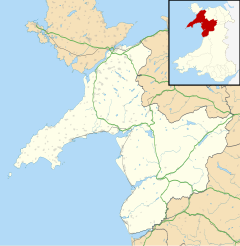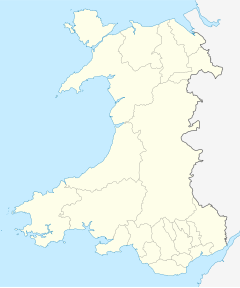Dinas Dinlle is a small settlement in Gwynedd, north-west Wales which is also, historically, part of Caernarfonshire.
| Dinas Dinlle | |
|---|---|
 Dinas Dinlle | |
Location within Gwynedd | |
| OS grid reference | SH435568 |
| Community | |
| Principal area | |
| Country | Wales |
| Sovereign state | United Kingdom |
| Post town | CAERNARFON |
| Postcode district | LL54 |
| Dialling code | 01286 |
| Police | North Wales |
| Fire | North Wales |
| Ambulance | Welsh |
| UK Parliament | |
| Senedd Cymru – Welsh Parliament | |
| Dinas Dinlle | |
|---|---|
| General information | |
| Architectural style | Iron Age hillfort |
| Country | Wales |
| Coordinates | 53°05′10″N 4°20′11″W / 53.086034°N 4.336252°W |
| Technical details | |
| Size | 150 m x 110m |
Description
editDinas Dinlle has a large sand and pebble beach with vast areas of sand from mid-tide level. The foreshore consists of natural pebble banks. The popular beach offers views towards the Llŷn Peninsula (Penrhyn Llŷn) and towards Ynys Llanddwyn (Llanddwyn Island) on Anglesey. The area is a designated Site of Special Scientific Interest (SSSI). According to the 2011 Census, 77.9% of the population were Welsh speakers.
A small airport, Caernarfon Airport, is nearby. During the Second World War this was an RAF base but now it is mainly used for flying lessons and pleasure flights. A caravan park is located nearby.
The erosion by the sea is a substantial problem. A groyne built in 1994 to alleviate the problem was thought to be a mistake that had made the situation worse by 2013. The height of the groyne was to be reduced and the large boulders removed. This was important to preserve the beach and the Wales Coast Path.[1]
Hillfort
editThe cliff above the beach is known as Boncan Dinas and is occupied by an Iron Age hillfort, Dinas Dinlle. This fort has been eroded by the sea, such that only a double semi-circular rampart remains. Finds of Roman pottery suggest reoccupation in the 2nd or 3rd centuries CE.[2] The fort is about 164 yards from north to south by 120 yards with an entrance on the south west. It is possible that a Roman lighthouse originally stood here.[3] It is possible to make out small depressions which are thought to indicate the sites of Iron Age huts and the mound may be the remains of a barrow.[4]
Archaeological excavations at Dinas Dinlle in 2019 found the remains of structures inside the hillfort. These included 13m-diameter stone-built roundhouse with walls over 2m thick, thought to be one of the largest ever found in Wales.[5] The excavations also found Roman coins and pottery dating from around 200CE to 300CE.[6] The archaeological work was undertaken by the Gwynedd Archaeological Trust and the RCAHMW with funding from the EU 'CHERISH' project.[7]
Gallery
editSee also
editReferences
edit- ^ Dinas Dinlle beach erosion plan unveiled, BBC News, February 2013, accessed 8 March 2013
- ^ "Aerial photograph of Dinas Dinlle Iron Age hillfort". Gathering The Jewels. Archived from the original on 27 September 2007. Retrieved 18 September 2006.
- ^ Royal Commission of the Ancient and Historical Monuments in Wales Dinas Dinlle Archived 2007-09-28 at the Wayback Machine (site 95309) accessed March 2013
- ^ Megalithic Portal Dinas Dinlle, accessed 8 March 2013
- ^ "Buried secrets revealed at Dinas Dinlle coastal fort". Current Archaeology (356). 17 September 2019.
- ^ Dinas Dinlle dig uncovers Iron Age roundhouse and Roman coinsbeach erosion plan unveiled (BBC News, 20 August 2019)
- ^ "Archaeology at the edge! CHERISH Project continues to unearth the secrets of Dinas Dinlle coastal fort (CHERISH website, accessed 9 October 2020)". Archived from the original on 16 October 2020. Retrieved 9 October 2020.

